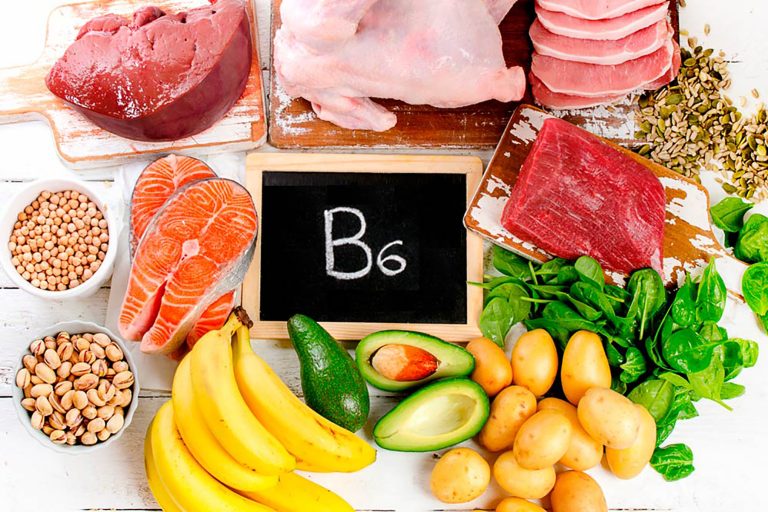Vitamin B6 is one of the vitamins of the B complex and is involved in many metabolic processes. Utopia explains what happens in the event of an overdose and which foods contain the vitamin.
As with many other vitamins, there is no such thing as “the one” vitamin B6. Rather, vitamin B6 is a collective term for various, very similar chemical compounds with the same biological effect on metabolism: These substances include, for example, pyridoxine, pyridoxal and pyridoxamine. Our body cannot produce these substances itself – which means we have to absorb them through food.
What are the functions of vitamin B6?

Like all vitamins of the vitamin B complex, vitamin B6 is also involved in a number of metabolic processes. As the most important coenzyme in amino acid metabolism, it is particularly important for protein metabolism. Together with folate, riboflavin and vitamin B12, vitamin B6 regulates homocysteine metabolism. Other functions of the vitamin are:
carbohydrate metabolism
fat metabolism
Formation of messenger substances and niacin
Effects on the immune system
Influencing hormone activity
What happens with vitamin B6 deficiency?
A vitamin B6 deficiency is very rare in healthy people and usually does not occur in isolation, but is usually accompanied by other vitamin deficiencies. The main reasons for a vitamin B6 deficiency are alcohol dependence, chronic diseases of the digestive system, side effects of certain medications or insufficient food intake (e.g. in older people). The symptoms of a vitamin B6 deficiency are diffuse:
anemia
neurological disorders
Diarrhea
Vomit
cramps
rashes
inflammation of the mouth
Overdose side effects
With a normal diet, it is not possible to absorb too much vitamin B6. Only those who overdose on vitamin B6-containing dietary supplements, medicines or fortified foods must expect serious side effects. Long-term intake of more than 500 mg of vitamin B6 per day can lead to neurological disorders, skin changes and muscle weakness. And even with a lower dosage of over 100 mg per day, slight neurological impairments can occur.
In an American study (2017), male participants who overdosed on vitamin B6 and vitamin B12 for years had a 30 to 40 percent increased risk of lung cancer. In addition, drugs can interact with vitamin preparations and impair their effectiveness.
Other side effects of overdosing on vitamin B6 include:
sensitivity to sunlight
skin rashes
Uncomfortable tingling in hands or feet
Painful discomfort or numbness
Due to these risks, the Federal Institute for Risk Assessment (BfR) has set a maximum amount of 3.5 mg vitamin B6 per day for food supplements. Nevertheless, it happens that vitamin preparations are overdosed and athletes in particular should be careful with special sports products: As the Bavarian State Office for Health and Food Safety determined in 2015, these dietary supplements sometimes provide more than 3000 percent of the daily requirement.
Daily requirement of vitamin B6
Because of the importance of vitamin B6 for the amino acid metabolism, it was previously assumed that the daily vitamin B6 requirement is related to the amount of protein that one ingests daily: the more protein one eats, the more vitamin B6 is needed to make it available in the body use the body for energy.
However, recent findings indicate that there is no connection between the intake of protein and the need for vitamin B6. For this reason, the German Society for Nutrition (DGE) revised the recommendations in 2019: The recommended intake of vitamin B6 for adults is now between 1.4 and 1.6 mg per day.
Which foods contain vitamin B6?

Vitamin B6 is very sensitive and also water-soluble. Heat and UV light damage it, so it is best to prepare foods rich in vitamin B6 gently or eat them raw and store them in the dark. If you cook food that contains vitamin B6, you should make sure that you use as little water as possible so that the vitamin is not released from the food.
Foods high in vitamin B6 include:
whole grain products
fatty sea fish (mackerel, salmon, sardines, kippers)
Soybeans and other legumes
meat (especially liver)
bananas
Nuts and seeds (walnuts, hazelnuts, sunflower seeds)
potatoes
Red pepper
carrots
Cauliflower
A large portion of potato or carrot salad (300 g), refined with a handful of walnuts, covers an adult’s daily vitamin B6 requirement. Although potatoes and carrots are not in season all year round, they are also available outside of the times indicated in the seasonal calendar from regional cultivation.

